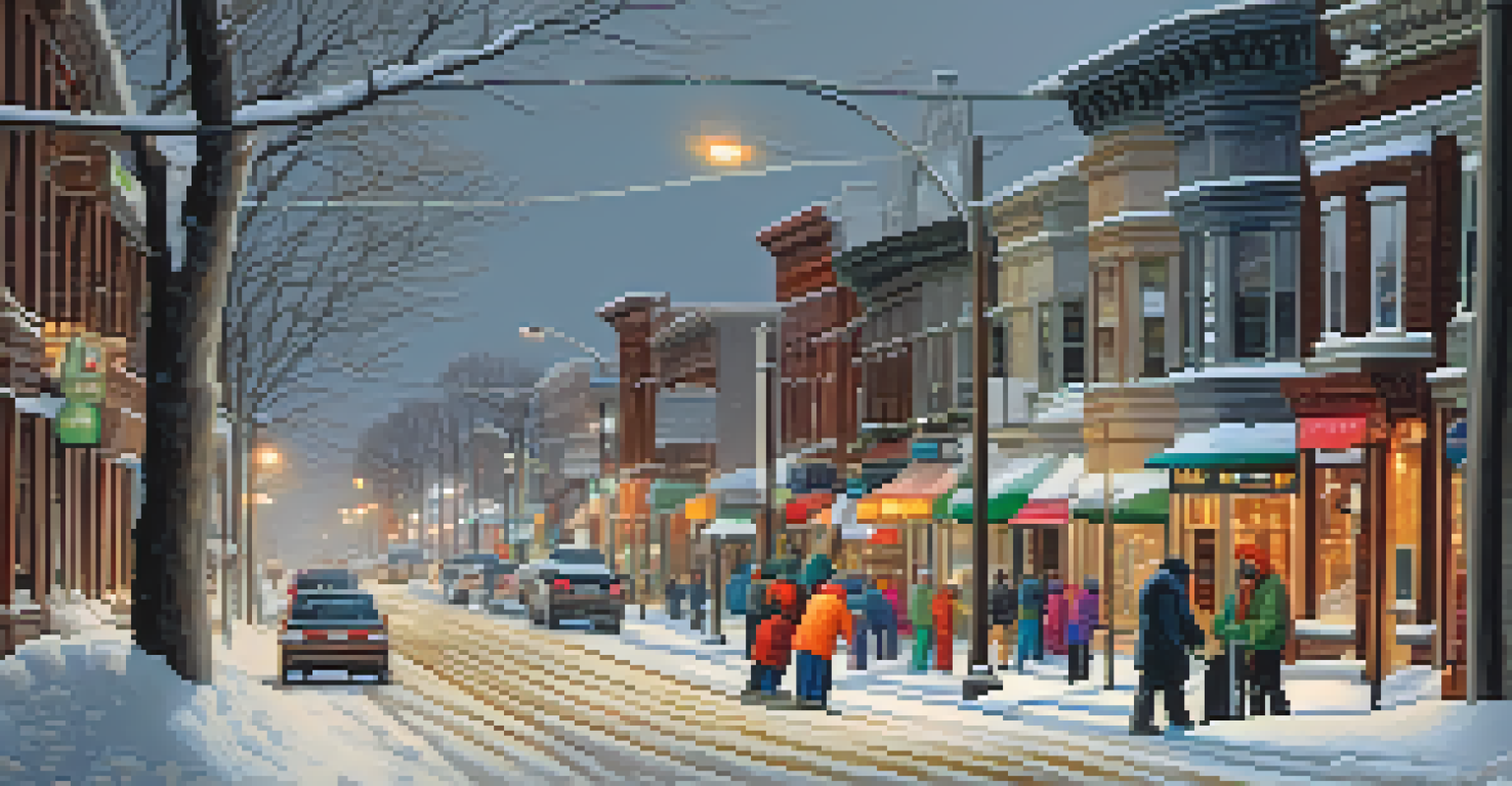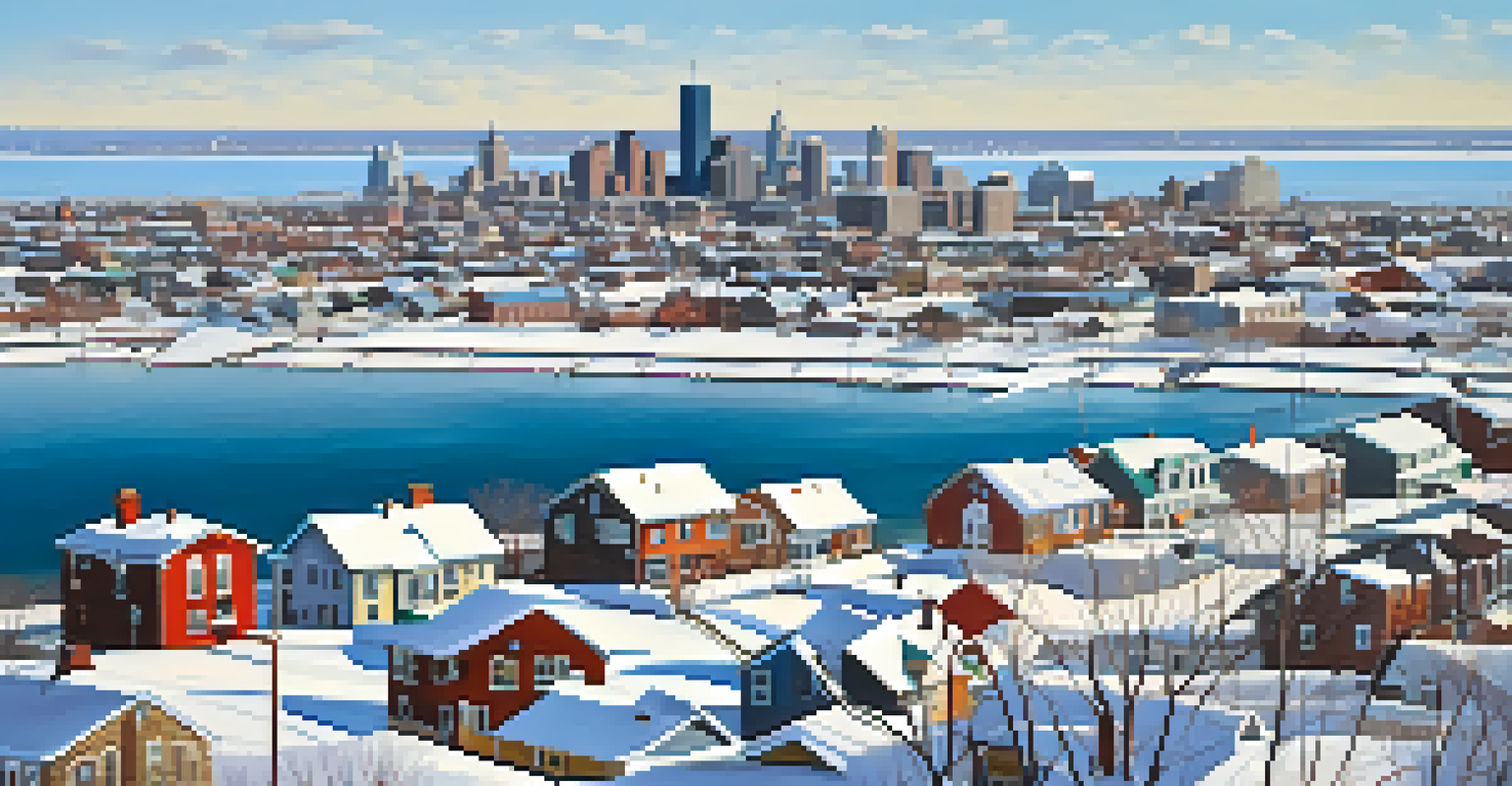Understanding Buffalo's Lake Effect Snowfall and Its Impact

What is Lake Effect Snowfall and How Does It Form?
Lake effect snowfall occurs when cold air moves over warmer lake waters, picking up moisture. This process creates clouds that eventually release snow as they pass over land. Buffalo, located near Lake Erie, is particularly susceptible to this phenomenon due to its geographic position.
Snowflakes are one of nature's most fragile things, but just look what they can do when they stick together.
When the cold air hits the warmer water, it can lead to heavy snowfall, often in localized areas. This is why some neighborhoods in Buffalo can see feet of snow while others just a few miles away remain relatively dry. It's like a snow machine that works on a very local scale, contributing to the city's unique winter climate.
Understanding lake effect snow is crucial for residents and city planners alike. The snow can be intense and sudden, affecting transportation and safety. By recognizing how this weather pattern forms, people can better prepare for the impacts it brings.
The Geography of Buffalo and Its Role in Snowfall Patterns
Buffalo's location is a key factor in its lake effect snowfall. Situated on the eastern shore of Lake Erie, the city benefits from the lake's influence throughout the winter months. The lake's size and temperature create ideal conditions for significant snowfall when cold winds blow over it.

The topography surrounding Buffalo also contributes to snow accumulation. The city is bordered by hills and valleys that can trap cold air and moisture, creating localized snow bands. This setup can lead to dramatic differences in snowfall within short distances, making the weather unpredictable.
Lake Effect Snow: How It Forms
Lake effect snowfall occurs when cold air moves over warmer lake waters, leading to localized heavy snow, especially in areas like Buffalo.
People living in Buffalo often share stories about how quickly the weather can change due to the lake's effects. One neighborhood might experience a winter wonderland, while just a few miles away, it’s barely snowing. This geographical quirk is part of what makes winter in Buffalo so fascinating.
Historical Context of Lake Effect Snow in Buffalo
Buffalo has a rich history of heavy snowfall, with records dating back over a century. Major snowstorms have shaped the city’s identity, creating a culture that embraces winter sports and activities. The infamous Blizzard of '77 is a prime example, where the city was paralyzed by extreme snowfall and wind.
In the depths of winter, I finally learned that within me there lay an invincible summer.
These historical events have led to the development of snow removal strategies and infrastructure improvements. Over the years, Buffalo has adapted to its snowy realities by investing in snow plows and salt spreaders, ensuring roads remain passable during heavy storms. The lessons learned from past winters continue to inform current practices.
The community's resilience is evident in how residents cope with the harsh winters. Buffalo's history with lake effect snow has fostered a sense of camaraderie among its citizens, as they share tips for navigating the snowy streets or recommend the best sledding hills. It's a shared experience that bonds the community together.
Impacts on Daily Life: Commuting and Activities
Lake effect snow significantly impacts daily commuting in Buffalo. With heavy snowfall often occurring overnight, residents can wake up to a winter wonderland that can create hazardous driving conditions. School and work delays are common, as city officials work to clear the roads for safe travel.
Public transportation is also affected by heavy snowfalls. Buses may experience delays or reroutes, and some routes may be temporarily suspended until conditions improve. This unpredictability can be frustrating for commuters who rely on public transport to get to work or school.
Buffalo's Unique Geography
Buffalo's position by Lake Erie and its surrounding topography create conditions for unpredictable and varying snowfall across short distances.
Despite the challenges, Buffalo residents have learned to embrace winter activities. From ice skating on frozen lakes to participating in local snow festivals, the community finds ways to enjoy the snowfall. Winter sports, such as skiing and snowboarding, have become integral parts of Buffalo's culture, showcasing the city’s ability to turn a snowy situation into an opportunity for fun.
Economic Effects of Lake Effect Snowfall
Lake effect snowfall also has economic implications for Buffalo. The tourism industry benefits from the influx of visitors seeking winter sports and activities, boosting local businesses. Ski resorts and winter festivals draw crowds, contributing to the city’s economy during the colder months.
However, heavy snowfall can also lead to increased costs for the city. Snow removal services require significant funding and resources, impacting the municipality's budget. Businesses may face losses due to closures or reduced customer traffic during severe storms, highlighting the dual-edged sword of winter weather.
Ultimately, Buffalo's economy is intertwined with its snowy winters. The city has learned to adapt and find balance, leveraging the opportunities winter brings while managing its challenges. This resilience is a testament to Buffalo's spirit and its ability to thrive even in the snowiest months.
Preparing for Lake Effect Snow: Tips for Residents
Preparation is key for Buffalo residents facing lake effect snow. Keeping a well-stocked emergency kit at home, including essentials like food, water, and batteries, is a smart move. Having a plan for snow days—whether it’s working from home or knowing the nearest shelter—is also crucial.
Residents should also stay informed about weather forecasts and snow alerts. Local news channels and apps provide real-time updates, helping individuals make informed decisions. By staying ahead of the weather, people can better navigate their plans and avoid hazardous situations.
Economic and Social Impact of Snow
While lake effect snow boosts winter tourism and local activities, it also imposes economic challenges through increased snow removal costs and disrupted daily life.
Additionally, investing in snow removal equipment, like shovels and snow blowers, can make a big difference. Regularly clearing driveways and sidewalks helps maintain safety and accessibility. With a little preparation, residents can enjoy the beauty of a snowy Buffalo without feeling overwhelmed by it.
The Future of Buffalo's Lake Effect Snowfall
As climate change continues to influence weather patterns, Buffalo's lake effect snowfall may also evolve. Warmer winters could alter the frequency and intensity of snow events, leading to changes in the city’s winter landscape. Understanding these shifts is essential for long-term planning and adaptation.
Meteorologists are studying these trends to predict how lake effect snow will behave in the coming years. By analyzing historical data and current conditions, they can provide valuable insights into future snowfall patterns. This research helps residents and city officials prepare for potential changes.

Ultimately, the spirit of Buffalo will remain resilient, regardless of the snowfall. The community's love for winter and its activities will endure, adapting to whatever Mother Nature brings. The future may hold surprises, but Buffalo's connection to its snowy winters is likely to stay strong.